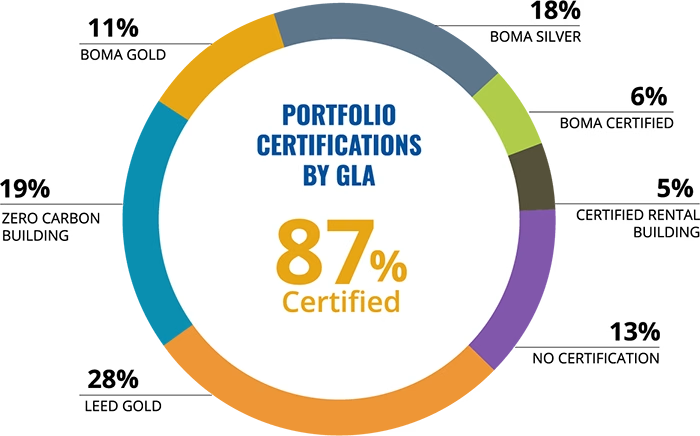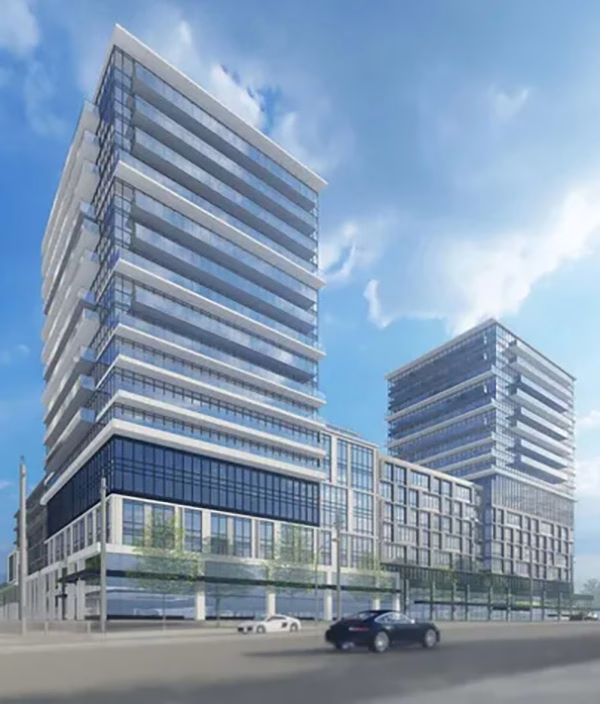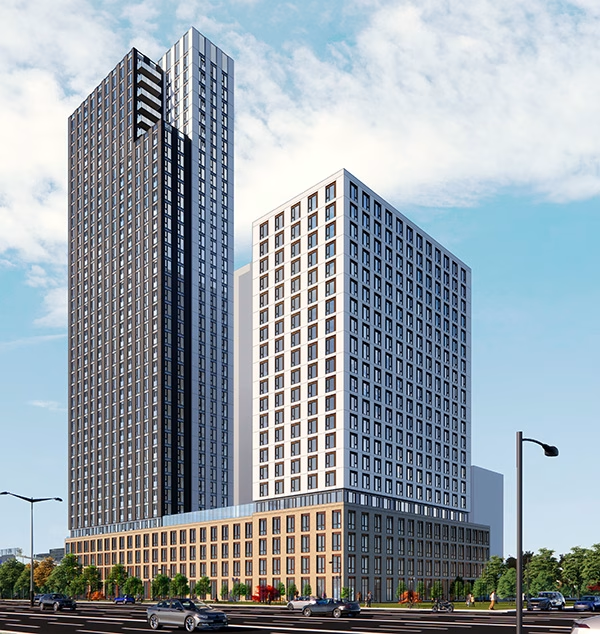Climate and
Environment
Decarbonization
We use a systematic, bottom-up approach to reduce carbon emissions.
Climate change represents a huge challenge and opportunity for the real estate industry. With buildings accounting for almost a fifth of carbon emissions in Canada, the real estate sector has an important role to play in decarbonization and limiting the impacts of climate change.
At KingSett, we recognize the significant opportunity to create value for our stakeholders by accelerating the transition to a low-carbon economy. We continue to build on our past success by setting emissions reduction targets, making prudent investment decisions and creating and executing our asset-level decarbonization strategies.
The transition to a net-zero carbon portfolio is a significant opportunity and requires long-term strategic planning. We have a systematic, bottom-up approach to identify and execute asset-level decarbonization strategies that meets or exceeds the Paris Climate Agreement.
Our Decarbonization Strategy
We define a decarbonization strategy as a property-level roadmap for management teams to achieve carbon reductions of over 50% from baseline. Our approach includes identifying opportunities in our existing portfolio and working with management teams and mechanical and electrical design consultants to understand where we need to take action before developing property-level strategies.
The implementation of our decarbonization strategies is consistent across asset classes. Once a property’s decarbonization plan has been completed, carbon credits are purchased for the residual emissions. Each property-level strategy includes:
- Assessing the property’s current energy use makeup and capital budget plans
- Targeting at least 50% carbon reductions from baseline
- Scoping projects to decarbonize operations including fuel switching, electrification, deep energy retrofits and increased tenant awareness and communication
Prerequisites to Decarbonize:
In 2021, we developed a decarbonization tool that models financial metrics, including capital budgets, inflation rates, interest rates and more, as well as utility performance and carbon emission reductions at both the asset and portfolio level. The tool helps us to identify strategic investments, inform our decision making and capture opportunities to reduce carbon emissions. This tool has been made public on KingSett’s website for all to download.
Offsetting Residual Emissions with Carbon Credits
We purchase carbon credits to offset any residual operational carbon that remains once the property’s decarbonization plan is complete. For emissions we cannot eliminate through energy efficiency initiatives, KingSett purchases carbon credits from reputable sources, such as Gold Standard, that verify the emissions reduction.
2020
- Certified 40 King St. W ZCB – Performance standard
- Internal whitepaper published on decarbonization retrofits
- Commenced carbon study of Fairmont Royal York
- Decarbonized Arthur Erickson Place’s domestic hot water system with CO2 heat pumps
2021
- Developed internal Decarbonization Modeling Tool
- Set CREIF short- and long-term carbon reduction targets of a 47% reduction by 2030 and 67% reduction by 2035, in alignment with SBTi
- Finalized Fairmont Royal York carbon study
- Broke ground on Valhalla Village Phase 1 geothermal system
2022
- Secured financing from the CIB for Fairmont Royal York decarbonization
- Decarbonized 100 Yonge St. using a market-leading heat pump and heat recovery system
2023
- Certified 100 Yonge St. to ZCB – Performance
- Decarbonized Fairmont Royal York and certified to ZCB – Performance
- Certified Arthur Erickson Place to ZCB – Performance
- Publicly launched KingSett’s Building Decarbonization Modelling Tool
2024
- Connected Atrium to Deep Lake Water Cooling system
- Achieved ZCB – Design certification for Valhalla Village Phase 1
- Secured $47M financing from the CIB towards decarbonization projects for seven assets
- Certified 1235 Bay St. to ZCB – Performance
2025
- Use SBTi methodology to quantify the total carbon emissions for KingSett’s AUM, potential targets and timelines
- Finalize decarbonization strategy for Bayshore Shopping Centre
- Finalize design of Valhalla Village Phase 2
- Execute studies to decarbonize 2 Bloor St. W, Midtown Mall and Burlington Centre
2026-2028
- Complete final phase of net-zero strategy at Arthur Erickson Place
- Complete decarbonization of 2.9M sf of Toronto core office properties
- Achieve ZCB – Design certification for Valhalla Village Phase 2
Case Study: Clean Connections
Atrium taps
into Deep
Lake Water Cooling
Atrium, a 1 million sf Class A office and retail complex in Toronto, is now connected to Enwave’s Deep Lake Water Cooling (DLWC) system, as part of KingSett’s broader sustainability and decarbonization efforts. By using cold water from Lake Ontario, the system provides efficient, low-carbon cooling, significantly reducing the building’s energy use and greenhouse gas emissions.
As the largest system of its kind in the world, DLWC serves much of downtown Toronto, including other KingSett-owned properties such as Fairmont Royal York Hotel, 700 Bay St. and 77/99 Gerrard St. This connection supports not only KingSett’s Sustainable Investing Strategy but also contributes to the city’s broader climate action goals by helping lower the carbon footprint of Toronto’s building stock.
Climate Risk
Management
We are committed to strengthening the resilience of our assets against both physical and transition climate-related risks.
By diversifying asset ownership, fund structure and strategy, we've built a product that unlocks value for our stakeholders while ensuring our assets are equipped to withstand various shocks and stressors. Our approach includes responsible capital allocation, managing operating costs, measuring and reducing carbon emissions, and striving to create healthy, comfortable buildings.
We support this by:
- Engaging extensively with stakeholders
- Adopting decarbonization carbon targets and certifications
- Investing to improve physical and transition resilience
- Assessing alternative low-carbon and reliable energy sources
Identifying, Assessing and Managing Climate Risks
Climate-related risks are the potential negative impacts associated with the transition to the low carbon economy and the physical impacts of climate change, including extreme weather and longer-term shifts in climate patterns.
We actively manage these risks across our assets to increase their long-term value and resilience. This includes conducting thorough assessments to identify how we can manage and mitigate the most material risks to our business. During acquisition, climate risks are integrated into our due diligence checklists, risk vulnerability assessments and reviewed by our Investment Committee. In ongoing asset management, we work closely with our third-party property managers to manage and mitigate climate-related risks. This process includes:
- Setting and tracking environmental KPIs for all properties including carbon emissions, water use, waste intensity and building certifications
- Implementing a Climate Resilience Policy for each asset and re-development project
- Reviewing flood plans and procedures at each property, including a Flood Emergency Response Plan
- Integrating climate resiliency features into capital planning and budgeting
- Assessing low-carbon energy sources for properties in Alberta and Saskatchewan
- Elevating climate risks and associated financial impacts to the Sustainability Committee
In 2023, we conducted a formal climate risk assessment of our CREIF portfolio for exposure to material climate risks that are relevant to our business.
In the table below, we provide an overview of our material climate risks, an assessment of our exposure to each risk and an explanation of the risk and its potential impacts. Our exposure to physical climate risks can significantly vary depending on asset type (residential, industrial, office) and geographic location.
| Transition Climate Risks | Exposure1 | Description of Risks and Potential Impacts |
|---|---|---|
| Climate-related Reporting Standards | High | There is significant momentum in jurisdictions around the world to regulate climate disclosures for public companies. If this happens, KingSett will need to ensure its climate disclosures keep pace with peers, investor needs and tenant requirements.
This could result in a higher cost of compliance to meet mandatory climate disclosures and potential loss of revenue from investors and tenants if our disclosures are not adequate. |
| Consumer Preferences and Demands | Moderate | Commercial and residential tenants and investors are increasingly seeking energy efficient, low-carbon properties to meet their climate goals. If KingSett’s properties fail to attract investors and tenants, this could negatively affect KingSett’s profitability. |
| Regulations Limiting Emissions | High | Canada has committed to reduce its greenhouse gas emissions by 30% below 2005 levels by 2030. The real estate sector accounts for 17% of the country’s emissions and the government may implement measures to reduce emissions from the real estate sector. If this happens, the potential impacts to our business could include higher costs associated with retrofitting existing buildings to meet emissions regulations and designing new low-carbon buildings. |
| Carbon Pricing | Medium | KingSett will be exposed to higher costs if there are no measures in place to reduce emissions or its decarbonization strategy takes longer than planned. Properties in certain jurisdictions (Vancouver) are more exposed than others to carbon pricing. |
| Physical Climate Risks | Exposure1 | Description of Risks and Potential Impacts |
|---|---|---|
| Storms | High | Most multi-residential and industrial properties in Ontario, British Columbia and Quebec are highly exposed to rain, wind and ice storms. This may result in property damage, increased cost of repair and cleanup, reduced property values and business continuity disruptions. |
| Floods | Moderate | A majority of industrial, retail, multi-residential and office properties in British Columbia, Alberta and Ontario are exposed to flood risks. Properties next to rivers, lakes or in existing flood plains areas have increased flood risk that could lead to property damage, reduced property values, damage to critical equipment and higher insurance costs. |
| Increased temperatures | High | Properties in Ontario are exposed to extreme heat risk. This may have greater implications for multi-residential properties when compared to office or industrial. Rising temperatures may result in increased energy costs associated with cooling or reduced values for properties without adequate cooling systems or insulation. |
Modelling Climate Resilience
Climate resilience is the ability to predict and respond to climate-related shocks and stressors. We use climate scenario analysis to assess KingSett’s resilience to climate-related risks, focusing on our CREIF portfolio. Using the Representative Concentration Pathways (RCPs), we examine the potential risks and opportunities across a range of plausible climate futures.
The RCPs describe four different scenarios based on different time horizons, temperature increases (including one capped at 1.5ºC) and policy assumptions. Across these scenarios, average temperatures, precipitation, and — over time — air pollutants emerge as significant risk factors.
Scenario analysis informs our planning and resilience strategies, helping us identify capital investment needs. To improve our climate resilience, each property undergoes a five-year assessment (where feasible), tracked with our data management system. From rising temperatures to flood risk and regulatory shifts, we address these challenges through our focus on decarbonization, capital investments and significant asset renewal — safeguarding our investments and fostering sustainable growth.
Case Study: Invested in Sustainability
CIB supports KingSett’s net-zero building transition with $47 million investment
The Canada Infrastructure Bank (CIB) is supporting KingSett Capital’s efforts to accelerate the reduction of greenhouse gas emissions in buildings across Toronto and Vancouver with a $47 million loan. This funding will enable green retrofits in commercial properties within KingSett’s portfolio.
Through this collaboration, KingSett will deliver large-scale energy efficiency and decarbonization upgrades, while also enhancing its ability to pursue further carbon reduction measures. These efforts are a key part of KingSett’s Sustainable Investing Strategy, which includes science-based targets to reduce carbon emissions by 35% by 2027 and 67% by 2035 from our 2019 baseline. CIB’s investment represents a meaningful step toward achieving those goals.


Performance
Data collection and analytics is not only table stakes for managing commercial real estate, but core for unlocking value across the real estate life-cycle. KingSett tracks its energy and water use, waste generation and carbon emissions to drive operational efficiency, identify potential projects, reduce negative environmental impacts and measure our progress against internal and external targets. The progress we’ve made since tracking data in 2016 is due to our innovative approach, focus by our teams and collaboration with our stakeholders.
By concentrating on enhancing the performance of our properties, we ensure they are positioned to deliver significant economic, environmental and social benefits when major systems are up for replacement. Doing so helps ensure our assets are renewed to better meet current and long-term climate risks and opportunities.
Energy
Energy Intensity (ekWh/sf) 1,2
234
eGWh of absolute energy consumption in 2024
1%
decrease in energy intensity vs 2023
23%
decrease in energy intensity vs 2019
17%
reduction vs 2019 by 2027 on track
CREIF’s office portfolio continues to maintain significant performance improvement compared to previous years as a result of most decarbonization and deep energy retrofit projects occurring in that asset class. This accounts for almost all of the portfolio's energy savings, 72 Million ekWh, since 2016. While multi-residential has seen the largest increase in energy use since 2016, it is wholly due to new developments (2 St. Thomas St. and 99 Gerrard St.) becoming operational in 2018 and 2019.
1 Energy intensity represents a like-for-like comparison of 91% of the CREIF portfolio by GLA, including new developments.
2 Energy data represents absolute consumption and is not normalized.
Carbon Emissions
Carbon Emissions (kgCO2e/sf) 3,4
34,161
tCO2e emitted in 2024
2%
decrease in carbon emissions intensity vs 2023
23%
decrease in carbon emissions intensity vs 2019
35%
reduction vs 2019 by 2027 on track
CREIF's carbon emissions performance follows similar trends to its energy performance, where the office portfolio is driving the bulk of the reductions for the portfolio. Enclosed retail, while reducing 13% energy use vs. 2016, also reduced 8% of its carbon emissions compared to the same period.
3 Carbon emissions intensity represents emissions from energy and is a like-for-like comparison of 91% of the CREIF portfolio.
4 Total scope 1, 2, 3 location-based emissions was 34,161 tCO2e in 2024.
Water
Water Intensity (L/sf) 5
1,009,054
m3 of water consumed in 2024
1%
increase in water intensity vs 2023
19%
reduction in water intensity vs 2019
Water use is highly correlated to occupancy and across the portfolio, when excluding new developments, all asset classes have seen strong reductions in consumption. As assets continue to evolve their operations to address how occupants consume water, we've seem a plateau in reductions year-over-year. Water use is expected to drop in the future as decarbonization creates opportunities for significant water reduction through the elimination of cooling towers.
5 Water intensity represents a like-for-like comparison of 91% of the CREIF portfolio by GLA, including new developments.
Waste
Waste Intensity (kg/sf) 6,7
9,590
tonnes of waste, recycling, organics generated in 2024
82%
waste data coverage
9%
decrease in waste intensity vs 2023
26%
decrease in waste intensity vs 2019
Waste generation is another performance metric that is highly correlated to occupancy, and while the commercial real estate industry typically reports on waste with a diversion percentage, we believe a much more valuable number is total waste and waste intensity, including recycling materials. Both total waste and waste intensity have changed relatively little compared to all other building performance metrics. This is mainly due to the little control property owners have on the generation of waste. We continue to rely on vendors and suppliers, occupants, and government to make the right decisions when it comes to packaging, disposal, and regulations around waste creation and management.
6 Waste intensity in 2024 covers 82% of the CREIF portfolio and is not a like-for-like comparison.
7 Waste intensity accounts for all waste and recycling streams.
Case Study: Building Resilience
Harnessing the power of sunlight at Kanata Lakes
Kanata Lakes, a luxury residential complex in Ottawa’s west end, is taking advantage of solar photovoltaic (PV) technology to boost energy efficiency, lower electricity costs for tenants and enhance climate resilience. Home to 731 residential and four commercial units, the property offers amenities such as in-suite laundry and exclusive access to a private clubhouse with a saltwater pool and gym. With its prime location near parks, shopping and entertainment, Kanata Lakes is well-positioned for sustainable upgrades that support both tenant satisfaction and environmental goals.
The installation of solar PV systems on two newly roofed buildings will be supported by the Ottawa DER Large Solar PV Funding Incentive, which improves the project’s return on investment when systems are designed for self-consumption. This initiative reflects a forward-looking approach to combining sustainability with economic efficiency in multi-residential real estate.
Building
Certifications
Building certifications offer an externally recognized and verifiable framework for evaluating and showcasing a building’s environmental performance and management by using established and credible frameworks recognized by the market.
KingSett is committed to adopting third-party building certifications to validate our properties’ positive impact and demonstrate their tangible benefits to tenants.
79%
of office properties by GLA are LEED O+M Gold or higher
3.6 M sf
achieved Zero Carbon Building – Performance certification across all funds

Case Study: Recognizing Leadership
Fairmont
Royal
York
The successful decarbonization of the iconic Fairmont Royal York Hotel marked a major milestone — demonstrating our ability to execute large-scale, complex decarbonization projects in historic buildings that deliver both environmental impactful and economic value.
This transformative effort has earned widespread recognition, with Fairmont Royal York and its project partners receiving multiple awards in 2024, including:
- Engineering News Record 2024 Global Best Projects – Green Projects category
- Ontario General Contractors Association Best Built Project
- Canadian Construction Association Environmental Achievement Award
The retrofit now serves as a benchmark for sustainable energy solutions in hotels and heritage properties.
Sustainable Development
New developments and site intensification projects have a significant impact on the environment and surrounding communities, which is why we have integrated sustainability considerations in each step of our development and redevelopment process. KingSett engages in all steps of the development cycle, from site consolidation and design development to entitlement and construction. To date, we have completed $4 billion of development projects, with another $1 billion currently under construction, $2 billion in the pipeline, and $2.4 billion in entitlement opportunities.
We strive to develop and redevelop real estate in a way that benefits all stakeholders. By focusing on healthy, comfortable, and efficient buildings, we seek to create lasting value for our investors, tenants, and the communities we serve.
CERTIFIED Valhalla Village Phase 1 to Zero Carbon Building – Design standard
91%
of all KingSett assets have a tenant fit-out program with sustainability-specific requirements
1.3M sf
in development pipeline designed with geothermal and/or air-source heat pumps
Next Steps
ACHIEVE ZCB – Design certification at Valhalla Village Phase 2

Valhalla Phase 2
Valhalla Village Phase 2 is a two-tower rental development located in Toronto’s Eatonville-Bloorlea neighbourhood. The project is being designed to meet the Zero Carbon Building – Design standard and features a geothermal energy system that uses the ground’s natural temperature to efficiently heat and cool the buildings. This system eliminates the need for natural gas-powered equipment, helping to significantly lower greenhouse gas emissions, a critical factor in reducing a building’s overall climate impact.

50 Wilson Heights
The redevelopment at 50 Wilson Heights Boulevard will deliver 1,484 new homes, including 35 percent affordable rentals, a childcare centre, parkland, retail, office and community spaces. The site is one of 17 identified for development under HousingNowTO, an initiative aimed at adding much-needed affordable and market housing supply to the City of Toronto by activating underutilized city-owned sites for development. This project demonstrates how private, government, and agency sectors can effectively collaborate to address the challenge of affordable housing in Toronto.

